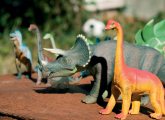Eleanor Johnson explores the ways in which audio resources can be used to promote children’s development…
Audio resources are an ideal tool for supporting and extending children’s learning. They can be used to encourage storytelling skills, support children’s exploration of the world around them and enhance imagination in the role-play area.
We all know how important it is for children to have good listening skills; how crucial they are for a child’s language and communication development, as well as reading and social interaction.
Planning structured listening activities provides opportunities for children to practise and consolidate these skills, and adds a multisensory element to an activity.
More than ever, publishers and content providers are creating good-quality audio resources, and it’s also straightforward to make your own, making it easier than ever to offer these activities in your setting.
Audio stories usually incorporate sound effects and music, and are often recorded by actors or celebrities. Songs and ‘joining in’ activities may also be included, and publishers often provide two versions of a story: a ‘listen along’ version, which is read all the way through, and a ‘read along’ version, which includes page turn prompts.
They are often accompanied by the printed book, but as following a text is quite a sophisticated skill, young children starting out on their reading journey may struggle with this.
However, they can follow the story by responding to the page-turn prompts. Children can also benefit from listening to the story without the book, allowing their imagination to take over.
Young children absorb and retain knowledge so easily through the medium of music and song. Alongside the old favourites, there are many companies creating wonderful new songs which are easy for young children to learn and sing along to.
These songs are often themed to topics such as animals or healthy living. Songs and rhymes provide an ideal means of introducing children to new vocabulary and concepts, and of consolidating learning.
Children’s phonological awareness can be supported by using environmental sounds games covering a wide range of subjects, from animals to musical instruments.
Listening games also encourage ‘active’ listening by requiring an action or response. You can encourage sound awareness and early communication skills by choosing songs and rhymes with a strong, steady beat.
Using familiar songs and rhymes can make it easier for children to learn a different language, so many foreign language resources use songs, rhymes and raps as their teaching focus.
These resources may be theme-based, for example, around colours, number, days of the week or greetings. Singing familiar songs in a different language also provides an ideal starting point for very young children.
These can be a good source of audio resources. The BBC School Radio service creates programmes to support the delivery of the early years curriculum. Many of the programmes are available as free podcasts.
Sometimes it’s not possible to find the audio resource you are looking for, so be creative and record your own.
Using audio resources adds another sensory element to an activity, but very young children should initially take part in these activities with the support and interaction of an adult.
As your children mature and become familiar with the idea that audio resources are a useful learning tool, they will be able to access them more independently and incorporate them into their own, child-initiated activities.
A children’s centre in Glasgow found that by listening to stories, children began discussing them with the adults more frequently. Children became very involved with the stories and also began chatting to their friends about them and sharing their experiences.
Reading to children introduces them to the language and structure of a story, and provides a model for their own storytelling.
When children learn to create, structure and tell their own story orally, they are laying down the foundations for reading and writing.
You can never replace the shared experience of reading with a child; however, audio stories are a wonderful way of enhancing and extending the pleasure of listening to a story.
At first, introduce an audio story by listening together with your children, encouraging interaction with the book and the audio track.
Some young children may find it easier to listen to very short stories at first, but as they gain experience, the tracks can become longer.
If you have some children who are struggling to listen to a story all the way through, then sung or rhyming stories may be hold their attention at first. Children should be given opportunities to listen individually, in pairs and in groups.
Audio stories can become a regular listening activity by placing tablets or CD players in your book corner. Props such as puppets and character toys can be placed alongside the players to accompany the stories and songs.
All children love a hidey-hole or den. Enclosed spaces can be very atmospheric and, for some children, can be seen as adventurous, exciting and thrillingly scary.
For others, they are spaces of enclosure, safe and inviting. Providing audio stories, songs and sound effects enhances this experience.
By providing children with appropriate resources they can create their own spaces which are themed to a particular audio story. For example:
An early years setting in Durham used Percy the Park Keeper to set up a wildlife role-play area. The practitioner dressed up as a wildlife warden and introduced the children to the animal sounds.
These sounds were then loaded onto devices and children listened to them and matched the sounds to the animals. The animal sounds became an integral part of the role-play area and added a listening activity along with the audio story.
The role-play area is an ideal place to incorporate audio resources. These could include animal sounds, environmental sounds and associated stories and songs. Why not try:
Another early years unit in Durham was visited by a company of Bollywood dancers. The children had independent access to the music via a device, enabling them to stage their own dance sessions.
Older children taught and coached the younger children, and eventually they created their own performance area, including seating for the audience.
Children love singing and performing. If music and songs are readily available then children can incorporate them into their own, child-initiated play. Try encouraging performing by providing:
Listening to audio resources whilst using creative resources can be a truly multisensory experience. For example, listening to a story or song while you and your children explore clay or playdough:
Eleanor Johnson has taught children at both the Foundation Stage and KS1, as well as those with speech and language difficulties. She is co-creator of the StoryPhones digital audio system.

Active learning in EYFS – How to encourage it
Editors picks

ICT in Early Years – The best resources for your setting
Editors picks
